Key Take Aways About Robinhood Day Trading Broker
- Robinhood democratized trading with commission-free trades, attracting novice investors.
- Generates revenue through payment for order flow, despite no commissions.
- Offers trades in stocks, ETFs, options, and cryptocurrencies, increasing risk and diversity.
- Provides real-time data but charges for detailed Level II data.
- Enables margin trading through Robinhood Gold, with high risk and potential for losses.
- Involved in the controversial 2021 GameStop saga which impacted its reputation.
- Insufficient education and support, potentially leaving traders unprepared.
- Day trading involves high risk, requiring psychological resilience and strategy.
- Few traders consistently profit; many face losses due to lack of discipline.

Understanding Robinhood in the Day Trading Scene
Sure, Robinhood’s got this reputation for being the go-to for all those rookie investors trying to dip their toes in the stock market without getting drowned in big fees. It’s like the gateway drug for trading. Launched back in 2013, they came out swinging with commission-free trades, and suddenly, everyone wanted a piece of the trading pie. It’s simple and straightforward, which makes it super appealing to the newbies out there. But day trading? That’s another beast altogether, and Robinhood’s role in that frenzy is worth a closer look.
Commission-Free Trading: A Double-Edged Sword
The zero-commission promise is a massive attraction, especially for folks who trade frequently. Without the burden of commission costs, you can imagine how some might feel like they’re in Vegas, betting without feeling the pinch of losing a bit on each trade. But hey, let’s not pretend this is just a charity act. Robinhood still makes money through stuff like payment for order flow, which means trades are sold to third-party market makers. Not a scam, but something to chew on.
Access to Financial Instruments
Robinhood isn’t just about stocks. There’s ETFs, options, and even cryptocurrencies. This kind of diversity lets a trader jump around to different hot spots. Take crypto, for instance—it’s like the rebel child of finance, and having access to it on Robinhood opens up new gambles. Options trading, though, cranks up the risk notch. You think stocks are risky? Options can make them look like child’s play.
Real-Time Market Data
Live data is crucial for day traders, and thankfully Robinhood provides it, but there’s a catch. To get access to more in-depth data (Level II), you’re ponying up for Robinhood Gold. Sure, it’s only five bucks a month, but for those serious about trading, it might be the difference between making it rain and crying in your soup.
The Margin Journey
Speaking of Robinhood Gold, it opens the door to margin trading. This is where things can get sticky. On one hand, it’s like getting to borrow extra funds to play with, which could mean bigger wins. But it’s a double-edger—losses can spiral out of control. Margin’s a slippery slope if not managed rightly, often leading to broker calls, which nobody wants.
The Controversial GameStop Saga
You’ve probably heard of the GameStop drama of 2021. Robinhood found itself smack dab in the middle of it. A mad rush from Reddit’s WallStreetBets pumped GameStop stocks, turning every day into a high-stakes roller coaster. Robinhood temporarily restricted buying of some stocks, leading to user outrage and conspiracy theories faster than you can say Reddit. While it’s behind us, it left a mark on Robinhood’s reputation.
The Role of Education and Support
Robinhood’s approach to educating users feels, well, basic. They’ve got articles and stuff but aren’t really holding your hand as you wander through the minefield of day trading. And customer support has had its hiccups too. Unless you dig into third-party resources or other educational materials, you might find yourself flying blind—something day traders need like a fish needs a bicycle.
Risk Factors in Day Trading on Robinhood
Day trading is like surfing: thrilling, but one wrong wave and you’re wiped out. Robinhood’s accessibility can sometimes make trading seem too easy, which might mislead some into thinking they can weather any storm. Volatility is part of the package, and without proper strategies and risk management, you could end up underwater fast.
The Psychology of Trading
Day trading is not for the faint-hearted. It’s a mental game as much as a financial one. The rush, greed, and fear are constantly at odds. It’s very easy to fall into a trap of emotional decisions when you’re seeing green and red flashing all around. Developing a disciplined approach isn’t just nice to have; it’s necessary for survival.
Success Stories and Cautionary Tales
There’s a handful of success stories out there—folks who’ve turned pennies to pounds, but they’re rare like unicorns. More often, there are tales of woe and regret. The reality is only a small percentage of day traders actually make consistent profits. For every savvy strategist, there’s someone who lost the farm because they didn’t know when to walk away.
In Conclusion
Robinhood’s made trading accessible, there’s no doubt about that. But when you step into day trading, it’s a whole other beast, full of thrills, risks, and learning curves sharp as a razor. It’s important to be aware of both the tools at your disposal and the pitfalls that come with them. If you’re ready to tango with the market, make sure you’re as prepared as a cat on a hot tin roof.